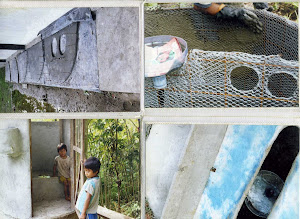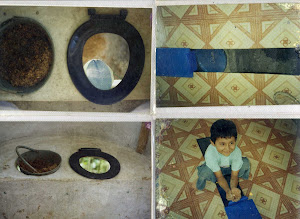Usuario informándose / User reading about the system.
Encofrado de la banca, con el refuerzo metálico del ferrocemento, tubo de ventilación, y forma para dejar libre el hueco (y los dos huequitos para los pernos del asiento). /
Wooden form for the bench, with the metallic reinforcing for the ferrocement, vent pipe and forms to keep the hole open (plus the two little holes for the bolts of the plastic seat).
A medio construir / Half built
Hola / Hi
Vista desde arriba (el saco no está puesto todavía) /
View from above /(the sack is not in place yet)
Embudo y tubo / Funnel and pipe
Puerta de atrás, del suelo hasta la banca. /
Back door, from the ground to the bench.
Kawshy con dos usuarias felices /
Kawshy with two happy users
Alistando el saco con aserrín / Preparing the sack with some sawdust
Los usuarios en la inauguración / Users at the opening ceremony
Conección a la caneca, afuera de la casita /
Connection to the jug, outside of the structure
Cosiendo la malla en el embudo /
Sewing the mesh into the funnel
En mayo de 2010, se inauguraron 8 Inodoros Ecológicos Secos en el sector rural de Tisaleo, en los Andes Centrales del Ecuador (un poco al sur de Ambato), en un proyecto liderado por Kawshalya Pathiraja, un voluntaria del Cuerpo de Paz de los Estados Unidos (sus padres son de Sri Lanka, al lado de la India), con el apoyo de la Fundación Manos Unidas. Ayudé con el diseño, la construcción y la educación.
Consideramos que es un diseño innovador, por su simplicidad, economía y su uso de materiales de fácil acceso:
- Hecho principalmente de bloques, con techo metálico, ya que es lo que la gente conoce y confía.
- Piso y banca de ferrocemento permiten dar la forma que queremos, con huecos donde queremos. Las cerámicas son colocadas directamente en el cemento fresco, tomando ventaja de que el área no es demasiado extensa.
- Tamaño justo, con dimensiones interiores de 120cm de largo y 90cm de ancho.
- Todo sellado debajo y un tubo de ventilación (11cm x 3m) para desalojar posibles olores.
- Embudo para la orina cortado de una botella plástica, con una malla plástica cosida en él para prevenir el ingreso de sólidos (como aserrín y papel) y para evitar que se salpique. El uso de una botella aumenta la replicabilidad y facilita su reemplazo a futuro.
- Colección de la orina en botellones por medio de un tubo de PVC (5cm) hasta salir de la estructura y una botella desechable de cola (de 1,35 litros, con una manguera pegada en su boca hasta llegar al final del botellón).
- Colección de las heces simplemente en un saco vacío de arroz, lo cual es extremadamente accesible y económico (junto con material secante). También es muy conveniente, ya que la humedad puede evaporarse a través de la tela del saco y el oxígeno puede filtrar hacia adentro. El saco está ubicado directamente sobre el suelo y templado abierto con 4 cuerdas Cuando se llena el saco, se le cierra y se le marca con la fecha. Luego, se le puede hacer rodar con un palo debajo del piso (con la fecha visible), mientras cumple su sentencia de 6 meses, como estamos en un país tropical. Sin embargo, si los usuarios prefieren, pueden usar un balde o tacho.
- A propósito, la cámara no tiene un piso de cemento, para reducir su huella ecológica y económica ... y para que cualquier líquido pueda filtrarse, incluyendo la lluvia que podría entrar por el tubo de ventilación, aunque, hasta ahora, no baja mucho porque la punta del tubo está cortado en un fuerte ángulo y cubierto con malla metálica. Esto da para una mayor apertura para mayor ventilación y la lluvia suele correr por la malla, quedando afuera del tubo.
- Bajo costo (números exactos muy pronto). Cada familia aportó $80, además de los fondos externos.
- - - - - - -
Ecological Dry Toilets in Tisaleo, in the Andes of Ecuador
In May 2010, 8 Ecological Dry Toilets were finished in the rural area around the town of Tisaleo, in the Central Andes of Ecuador (a bit south of Ambato), in a project led by Kawshalya Pathiraja, a Peace Corps Volunteer from the United States (her parents are from Sri Lanka), with support from the local Manos Unidas Foundation. I helped with design, building and education.
We consider this design to be somewhat innovative, for its simplicity, economy and use of readily accessible materials:
- Built mainly of cement blocks, with a metal roof, as this is what the people know and trust.
- Ferrocement floor and bench allow whatever shape we want, with holes wherever we want. The ceramic tiles are placed directly into the fresh cement, taking advantage of the fact that we can reach.
- Good size, measuring 120cm long and 90cm wide inside.
- Everything is sealed below and a vent pipe (11cm x 3m) pulls any potential smells out.
- The urine funnel is cut from a plastic bottle, with plastic mesh sewed into it to prevent the entry of solids (like sawdust and paper) and to avoid splashing. Use of such a bottle increases replicability and facilitates future replacement.
- Urine is collected in jugs, via a PVC pipe (5cm) to the outside of the structure, where it inserts into a disposable beverage bottle (1.35 liters, with a hose glued into its mouth that runs to the bottom of the jug).
- Feces are collected simply in empty rice sacks, which are extremely accessible and economical (together with dry cover material). Sacks are also very convenient, since humidity can evaporate out of the sack and oxigen can filter in. They sit on the soil and are held open with 4 cords, while in the "line of fire". When they fill, they are tied shut and marked with the date to know when they have fulfilled their 6-month jail sentence, as we are in a tropical country. Then, it can be rolled using a stick to under the floor (with the date visible). Nevertheless, if users prefer, they can use buckets or barrels.
- On purpose, the chamber has no cement floor, to reduce the ecological and economical footprint ... and so that any liquids can soak into the ground, including the rain that may enter via the vent pipe, although, up until now, not much enters, since the top of the pipe is cut at a steep angle and covered with a metallic mesh. This allows for greater ventilation and the rain tends to run down the mesh and stay out of the pipe.
- Low cost (exact numbers soon). Each family contributed $80, in addition to outside funding.
















